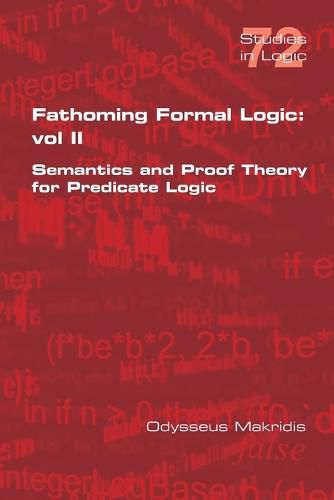Readings Newsletter
Become a Readings Member to make your shopping experience even easier.
Sign in or sign up for free!
You’re not far away from qualifying for FREE standard shipping within Australia
You’ve qualified for FREE standard shipping within Australia
The cart is loading…






This title is printed to order. This book may have been self-published. If so, we cannot guarantee the quality of the content. In the main most books will have gone through the editing process however some may not. We therefore suggest that you be aware of this before ordering this book. If in doubt check either the author or publisher’s details as we are unable to accept any returns unless they are faulty. Please contact us if you have any questions.
This text, volume II of a two-volume work, examines in depth the so-called standard predicate logic. Including a foundational lexicon of terms and a detour through the classical propositional logic, this volume can be used independently of the first.
As a means toward teasing out theoretical subtleties and negotiating formal and philosophic challenges, this work uses detailed examples and exercises; because of this feature, the text can also be used to study formal logic in a rigorous fashion.
Given its expressive power, predicate logic is deemed as minimally adequate for formalization of such fundamental languages as that of Mathematics and for translations of the meanings of English (or other natural-language) sentences. Laying foundations in this area is key to a technical understanding of deductive reasoning and to honing rigorous critical thinking and problem-solving skills.
Notable (some of them unusual) features that are covered in the present volume include the following:
The overview of propositional logic includes positive semantic trees, in addition to the negative semantic tree method. Prenex forms and conversion to equivalent prenex forms. Relational (ultimately polyadic) predicate symbols, function symbols and identity are made available.
The decision problem and the L wenheim Result are discussed. Proof-theoretic methods are presented analytically and extensive justifications are offered for the required restrictions on the deduction rules. The semantics of predicate logic modeling are presented in analytical detail along with inquiries into the logical-philosophical significance of predicate logic.
Translation from English into the predicate logic idiom (formalization, symbolization) is examined thoroughly, accompanied by motivating linguistic observations and thorough scrutiny of available options; aspects of this inquiry include translations under restricted and unrestricted domains, translations of compacted predicates, rendering of non-classically quantified phrases, translations of numerical statements, definite descriptions and regimentation, and guidance on how to render existential presuppositions. Disambiguation is imposed on translations and an extensive list of examples is presented.
Translations of idiomatic linguistic expressions are studied. Semantic tree decision procedures (for finitarian domains) - including negative and positive semantic tree systems - are constructed and applied.
Appendices on Set Theory, Mathematical Induction and Dialogical Logic are presented.
$9.00 standard shipping within Australia
FREE standard shipping within Australia for orders over $100.00
Express & International shipping calculated at checkout
Stock availability can be subject to change without notice. We recommend calling the shop or contacting our online team to check availability of low stock items. Please see our Shopping Online page for more details.
This title is printed to order. This book may have been self-published. If so, we cannot guarantee the quality of the content. In the main most books will have gone through the editing process however some may not. We therefore suggest that you be aware of this before ordering this book. If in doubt check either the author or publisher’s details as we are unable to accept any returns unless they are faulty. Please contact us if you have any questions.
This text, volume II of a two-volume work, examines in depth the so-called standard predicate logic. Including a foundational lexicon of terms and a detour through the classical propositional logic, this volume can be used independently of the first.
As a means toward teasing out theoretical subtleties and negotiating formal and philosophic challenges, this work uses detailed examples and exercises; because of this feature, the text can also be used to study formal logic in a rigorous fashion.
Given its expressive power, predicate logic is deemed as minimally adequate for formalization of such fundamental languages as that of Mathematics and for translations of the meanings of English (or other natural-language) sentences. Laying foundations in this area is key to a technical understanding of deductive reasoning and to honing rigorous critical thinking and problem-solving skills.
Notable (some of them unusual) features that are covered in the present volume include the following:
The overview of propositional logic includes positive semantic trees, in addition to the negative semantic tree method. Prenex forms and conversion to equivalent prenex forms. Relational (ultimately polyadic) predicate symbols, function symbols and identity are made available.
The decision problem and the L wenheim Result are discussed. Proof-theoretic methods are presented analytically and extensive justifications are offered for the required restrictions on the deduction rules. The semantics of predicate logic modeling are presented in analytical detail along with inquiries into the logical-philosophical significance of predicate logic.
Translation from English into the predicate logic idiom (formalization, symbolization) is examined thoroughly, accompanied by motivating linguistic observations and thorough scrutiny of available options; aspects of this inquiry include translations under restricted and unrestricted domains, translations of compacted predicates, rendering of non-classically quantified phrases, translations of numerical statements, definite descriptions and regimentation, and guidance on how to render existential presuppositions. Disambiguation is imposed on translations and an extensive list of examples is presented.
Translations of idiomatic linguistic expressions are studied. Semantic tree decision procedures (for finitarian domains) - including negative and positive semantic tree systems - are constructed and applied.
Appendices on Set Theory, Mathematical Induction and Dialogical Logic are presented.